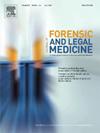Contributions of betahydroxybutyrate (BHB) determination and thanatological biochemistry in postmortem diagnosis of ketoacidosis-related fatalities: two case reports
IF 1.2
4区 医学
Q3 MEDICINE, LEGAL
引用次数: 0
Abstract
Postmortem biochemical analyses are increasingly recognized as valuable tools to complement traditional forensic investigations, particularly in cases where the cause of death remains unclear after autopsy and toxicological analyses. Among these, the quantification of β-hydroxybutyrate (BHB) in femoral blood (FB) and/or vitreous humor (VH) has proven crucial in identifying fatal ketoacidosis. The authors report two forensic cases in which targeted biochemical markers (including BHB, vitreous glucose, creatinine, and blood HbA1c) were evaluated to support the diagnosis of metabolic fatal metabolic disturbances. The first case involved a 57-year-old man with a known history of mellitus diabetes and chronic alcohol abuse, found deceased at home with postmortem genital mutilations. The second case concerned a 75-year-old diabetic man discovered in a neglected state after several weeks of insulin withdrawal. In both cases, toxicological findings were non-conclusive. However, markedly elevated BHB concentrations were observed in FB and VH, strongly supporting a diagnosis of ketoacidosis. In Case 1, the combination of chronic alcohol abuse together with elevated BHB concentrations in FB and VH suggested alcoholic ketoacidosis (AKA), with possible contribution from underlying diabetic condition. In Case 2, the history of prolonged insulin deprivation, abnormally high vitreous glucose concentration, and markedly increased BHB concentrations in FB and VH were consistent with diabetic ketoacidosis (DKA). Elevated vitreous creatinine and reduced estimated glomerular filtration rate (eGFR) further supported pre-existing renal dysfunction in both cases. These findings highlight the importance of integrating biochemical markers into routine postmortem protocols, as they may provide critical insights into otherwise unexplained deaths.
羟基丁酸(BHB)测定和死亡生物化学在酮症酸中毒死亡的死后诊断中的贡献:两例报告
死后生化分析日益被认为是补充传统法医调查的宝贵工具,特别是在尸体解剖和毒理学分析后死因仍不清楚的情况下。其中,定量测定股血液(FB)和/或玻璃体体液(VH)中β-羟基丁酸酯(BHB)已被证明对确定致死性酮症酸中毒至关重要。作者报告了两个法医病例,其中评估了靶向生化标志物(包括BHB、玻璃体葡萄糖、肌酐和血HbA1c),以支持代谢性致命代谢紊乱的诊断。第一个病例涉及一名已知有糖尿病和慢性酒精滥用史的57岁男子,在家中被发现死于死后生殖器残割。第二宗个案涉及一名75岁糖尿病男子,在停用胰岛素数周后被发现处于被忽视的状态。在这两种情况下,毒理学结果都是非结论性的。然而,在FB和VH中观察到明显升高的BHB浓度,强烈支持酮症酸中毒的诊断。在病例1中,慢性酒精滥用与FB和VH中BHB浓度升高的结合提示酒精性酮症酸中毒(AKA),可能与潜在的糖尿病状况有关。在病例2中,长期胰岛素剥夺病史,玻璃体葡萄糖浓度异常高,FB和VH中BHB浓度明显升高,与糖尿病酮症酸中毒(DKA)一致。玻璃体肌酐升高和肾小球滤过率(eGFR)降低进一步支持了这两例患者先前存在的肾功能障碍。这些发现强调了将生化标记纳入常规尸检协议的重要性,因为它们可能为其他原因不明的死亡提供关键见解。
本文章由计算机程序翻译,如有差异,请以英文原文为准。
求助全文
约1分钟内获得全文
求助全文
来源期刊

Journal of forensic and legal medicine
MEDICINE, LEGAL-
CiteScore
2.70
自引率
6.70%
发文量
106
审稿时长
57 days
期刊介绍:
The Journal of Forensic and Legal Medicine publishes topical articles on aspects of forensic and legal medicine. Specifically the Journal supports research that explores the medical principles of care and forensic assessment of individuals, whether adult or child, in contact with the judicial system. It is a fully peer-review hybrid journal with a broad international perspective.
The Journal accepts submissions of original research, review articles, and pertinent case studies, editorials, and commentaries in relevant areas of Forensic and Legal Medicine, Context of Practice, and Education and Training.
The Journal adheres to strict publication ethical guidelines, and actively supports a culture of inclusive and representative publication.
 求助内容:
求助内容: 应助结果提醒方式:
应助结果提醒方式:


